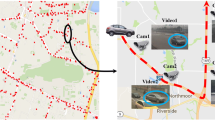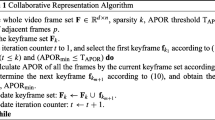Abstract
In multi-source surveillance videos, a large number of moving objects are captured by different surveillance cameras. Although the regions that each camera covers are seldom overlapped, similarities of these objects among different videos still result in tremendous global object redundancy. Coding each source in an independent way for multi-source surveillance videos is inefficient due to the ignoring of correlation among different videos. Therefore, a novel coding framework for multi-source surveillance videos using two-layer knowledge dictionary is proposed. By analyzing the characteristics of multi-source surveillance videos in large scale of spatio and time space, a two-layer dictionary is built to explore the global object redundancy. Then, a dictionary-based coding method is developed for moving objects. For any object in multi-source surveillance videos, only some pose parameters and sparse coefficients are required for object representation and reconstruction. The experiment with two simulated surveillance videos has demonstrated that the proposed coding scheme can achieve better coding performance than the main profile of HEVC and can preserve better visual quality.
Access this chapter
Tax calculation will be finalised at checkout
Purchases are for personal use only
Similar content being viewed by others
References
Wiegand, T., Sullivan, G.J., Bjøntegaard, G., Luthra, A.: Overview of the H.264/AVC video coding standard. IEEE Trans. Circuits Syst. Video Technol. 13(7), 560–576 (2003)
Sullivan, G.J., Ohm, J., Han, W., Wiegand, T.: Overview of the high efficiency video coding(HEVC) standard. IEEE Trans. Circuits Syst. Video Technol. 22(12), 1649–1668 (2012)
Paul, M., Lin, W. et al.: A Long-term reference frame for hierarchical B-picture-based video coding. IEEE Trans. Circuits Syst. Video Technol. 24(10), 1729–1742 (2014)
Zhang, X., Huang, T., Tian, Y., Gao, W.: Background-modeling-based adaptive prediction for surveillance video coding. IEEE Trans. Image Process. 23(2), 769–784 (2014)
Zhang, X., Tian, Y., Huang, T., Dong, W., Gao, W.: Optimizing the hierarchical prediction and coding in HEVC for surveillance and conference videos with background modeling. IEEE Trans. Image Process. 23(10), 4511–4526 (2014)
Ng, K., Wu, Q., Chan, S., Shum, H.: Object-Based Coding for plenoptic videos. IEEE Trans. Circuits Syst. Video Technol. 20(4), 548–562 (2010)
Tsai, T., Lin, C.: Exploring contextual redundancy in improvingobject-based video coding for video sensornetworks surveillance. IEEE Trans. Multimedia 14(3), 669–682 (2012)
Yue, H., Sun, X., Yang, J., Wu, F.: Cloud-based image coding for mobile devices—toward thousands to one compression. IEEE Trans. Multimedia 15(4), 845–857 (2013)
Shi, Z., Sun, X., Wu, F.: Feature-based image set compression. In: IEEE International Conference on Multimedia and Expo, pp. 1–6 (2013)
Xiao, J., Chen, Y., Hu, J., Hu, R.: Global coding of multi-source surveillance video data. In: Data Compression Conference, pp. 33–42 (2015)
Xiao, J., Liang, L., Hu, J., Chen, Y., Hu, R.: Exploiting global redundancy in big surveillance video data for high efficient coding. J. Cluster Comput. (2014)
Tan, T.N., Sullivan, G.D., Baker, K.D.: Model-based localization and recognition of road vehicles. Int. J. Comput. Vis. 27(1), 5–25 (1998)
Aharon, M., Elad, M., Bruckstein, A.: K-SVD: an algorithm for designing over-complete dictionaries for sparse representation. IEEE Trans. Sig. Process. 54(11), 4311–4322 (2006)
Liu, Q., Liang, D., Song, Y., et al.: Augmented Lagrangian based sparse representation method with dictionary updating for image deblurring. SIAM J. Imaging Sci. 6(3), 1689–1718 (2013)
Liu, Q., Wang, S., Ying, L., et al.: Adaptive dictionary learning in sparse gradient domain for image recovery. IEEE Trans. Image Process. 22(12), 4652–4663 (2013)
Tropp, J.A., Gilbert, A.C.: Signal recovery from random measurements via orthogonal matching pursuit. IEEE Trans. Inf. Theory 53(12), 4655–4666 (2007)
Acknowledgments
This work was partly supported by the China Postdoctoral Science Foundation (2014M562058), Scientific Research Foundation for the Returned Overseas Chinese Scholars, State Education Ministry ([2014]1685), Fundamental Research Funds for the Central Universities (2042014kf0025, 2042014kf0286), EU FP7 QUICK project (PIRSES-GA-2013-612652).
Author information
Authors and Affiliations
Corresponding author
Editor information
Editors and Affiliations
Rights and permissions
Copyright information
© 2015 Springer International Publishing Switzerland
About this paper
Cite this paper
Chen, Y., Xiao, J., Liao, L., Hu, R. (2015). Non-overlapped Multi-source Surveillance Video Coding Using Two-Layer Knowledge Dictionary. In: Ho, YS., Sang, J., Ro, Y., Kim, J., Wu, F. (eds) Advances in Multimedia Information Processing -- PCM 2015. PCM 2015. Lecture Notes in Computer Science(), vol 9314. Springer, Cham. https://doi.org/10.1007/978-3-319-24075-6_68
Download citation
DOI: https://doi.org/10.1007/978-3-319-24075-6_68
Published:
Publisher Name: Springer, Cham
Print ISBN: 978-3-319-24074-9
Online ISBN: 978-3-319-24075-6
eBook Packages: Computer ScienceComputer Science (R0)




